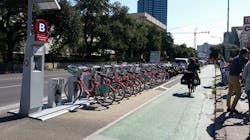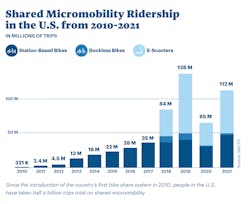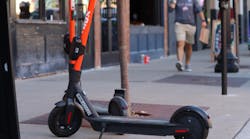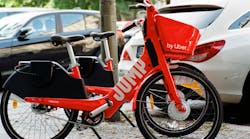NACTO: Micromobility is booming; municipal regulations towards it need to evolve
The National Association of City Transportation Officials (NACTO) released a new data snapshot that found micromobility use in the U.S. isn’t a trend but a crucial part of transportation networks. NACTO’s analysis determined at least half a billion trips have been taken on bike share, e-scooters and other micromobility systems since 2010.
The association explains these modes of transport were a key to moving essential workers during the pandemic and have become “a crucial part of urban transportation networks across the U.S.”
“Shared bikes and e-scooters are embedded within the day-to-day lives of millions of people,” said Corinne Kisner, executive director of NACTO. “Well-designed micromobility programs mean safer, more sustainable and resilient cities. By redesigning streets, lowering speeds and prioritizing bikeway projects, local leaders can ensure the bike and scooter boom continues to gain momentum, connecting people to the opportunities in their cities.”
NACTO’s new 2020-2021 Shared Micromobility report examines data from cities across the U.S. NACTO found shared e-bike trips nearly doubled between 2018 and 2021, which it credited to the adoption of bastion-based e-bike systems.
Similar to other modes of shared mobility, micromobility options also reflected the shift in travel patterns away from traditional morning and afternoon rush to more trips throughout the day. Unlike other modes of shared mobility, which largely are struggling with reduced ridership, shared micromobility ridership in the U.S. nearly rebounded to pre-pandemic levels in 2021 with 112 million trips.
“Since the arrival of shared micromobility in 2018, e-scooters and e-bicycles have proven to be an important mobility option in Baltimore,” said Meg Young, interim transit and multimodal chief for the city of Baltimore, Md. “Whether they supplement transit or replace a car ride, these options edge us closer to a more complete transit ecosystem. Cities like Baltimore must continue to partner in innovation and ensure that equity and community are central tenets in emerging transportation.”
The analysis finds cities across the U.S. have expanded micromobility service in the past two years, targeting previously underserved communities and strengthening equity requirements for operators.
“In Chicago, we have seen some exciting trends in shared micromobility trips over the last few years. In a 2020 survey of e-scooter customers, nearly 30 percent of the riders reported they would have used a personal or rideshare vehicle if e-scooters had not been available, demonstrating the value to the city of having this low carbon mobility choice” said Sean Wiedel, assistant commissioner for citywide services at the Chicago Department of Transportation. “We’ve seen record ridership in 2021 and 2022, and our recently-launched scooter license program has seen nearly 40 percent of trips start or end in equity priority areas.”
The snapshot also highlights the key role micromobility has played in keeping people and economies moving even in times of disruption. In New York, a Citi Bike station near several major Manhattan hospitals became the most-used station in 2020, a dramatic rise from its ranking as the 59th most-used in 2019. In Washington D.C., reduced transit service caused by maintenance issues prompted Capital Bikeshare to offer free 30-day passes. During that time, 89 percent of Capital Bikeshare users were new riders, suggesting that transit riders shifted trips from transit to bike share.
“Citi Bike has helped fuel New York City’s bicycling boom since the pandemic, proving to be a critical transportation tool for essential workers and a pillar of the city’s economic recovery,” said New York City Department of Transportation Commissioner Ydanis Rodriguez. “As NACTO notes, our work to build a dense network of stations has helped generate more and more trips on the largest bike share network in the country. We look forward to continuing the expansion of this popular service into Brooklyn, the Bronx and Queens and build on our successes.”
Changing regulations
While NACTO’s analysis shows the popularity of micromobility options, the association believes the continued growth means municipal approaches to regulating micromobility must evolve.
In 2021, NACTO says more cities issued request for proposals for micromobility systems and, in some cities, even created new mechanisms to combine bikes and e-scooters into single contracting agreements. The association says strong city-operator partnerships with smart regulatory frameworks delivered systems that supported a variety of trip needs.
“Over the past two years, with the help of NACTO and our peer cities, we’ve refined our regulations to bring more devices and generate more rides in all Providence neighborhoods,” said Liza Farr, parking administrator for the city of Providence Department of Public Works. “As we continue to prioritize making our streets safer for all, it is clear that micromobility continues to be a vital piece of the puzzle for Providence residents and visitors alike to get where they need to go.”
Despite advances in equity, NACTO’s snapshot also notes a potentially worrying trend: Trip prices have increased substantially since 2018, especially in systems where prices are not regulated by the city. Trip costs for e-scooters and e-bikes have more than doubled since 2018.
“It is important to the city of Grand Rapids that we have many transportation options, so we are an accessible city, and it’s even more important these options are affordable,” said Josh Naramore, mobile GR director of the city of Grand Rapids. “Interest in share micromobility continues to be strong in Grand Rapids, with people using shared micromobiity to get to work, run errands and explore our community. As we expand bike and scooter share into more neighborhoods, we are working closely to ensure these services are lower-cost options, especially in our neighborhoods of focus.”
In addition to the snapshot, NACTO also published a new working paper, “Shared Micromobility Permitting, Process and Participation”, which outlines emerging trends in how cities manage micromobility networks, including the growth of electrified devices, the selection of operators based on strategic goals and regulations to better organize devices. The paper offers several tactics for making systems more equitable and effective, ranging from creating collaborative planning processes to investing in bike infrastructure and piloting low-speed zones for vehicle traffic.
-----------------
NACTO's full 2020-2021 Shared Micromobility report is available on its website.
A link to NACTO's working paper, “Shared Micromobility Permitting, Process, and Participation," is provided here.
Mass Transit Staff Report
Stories under this byline were produced through a team effort by the editorial staff of Mass Transit.
To learn more about our team, click here.
If you have a story idea, let us know by emailing [email protected]. Please review our contributor guidelines found here.







